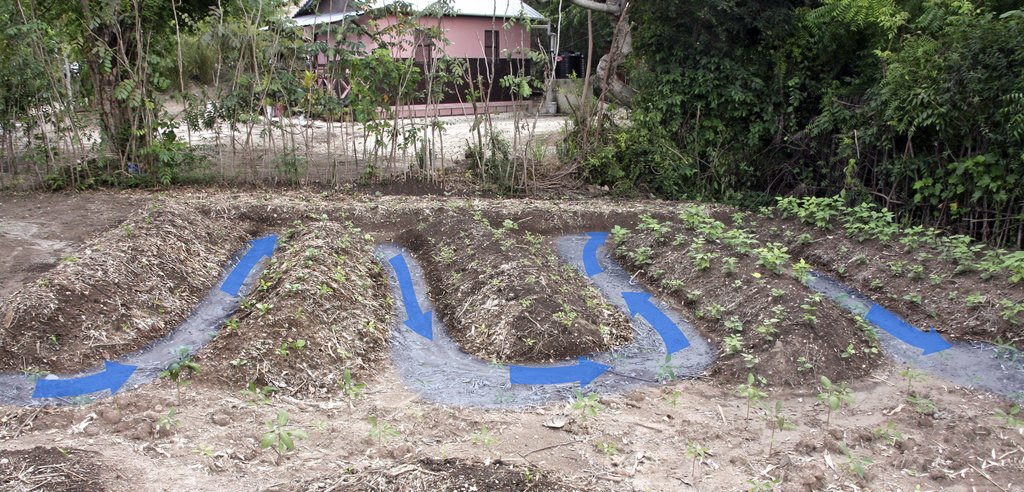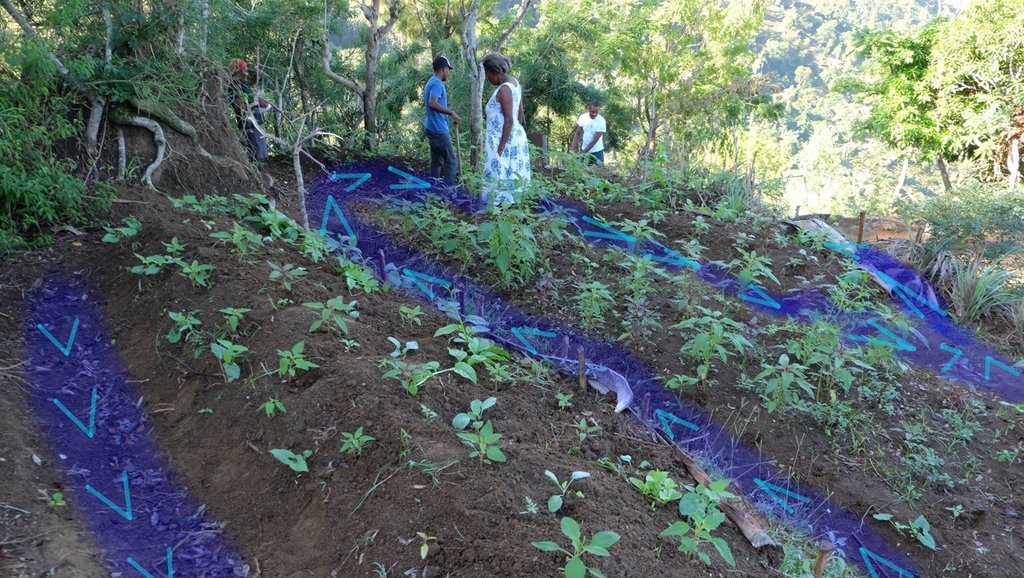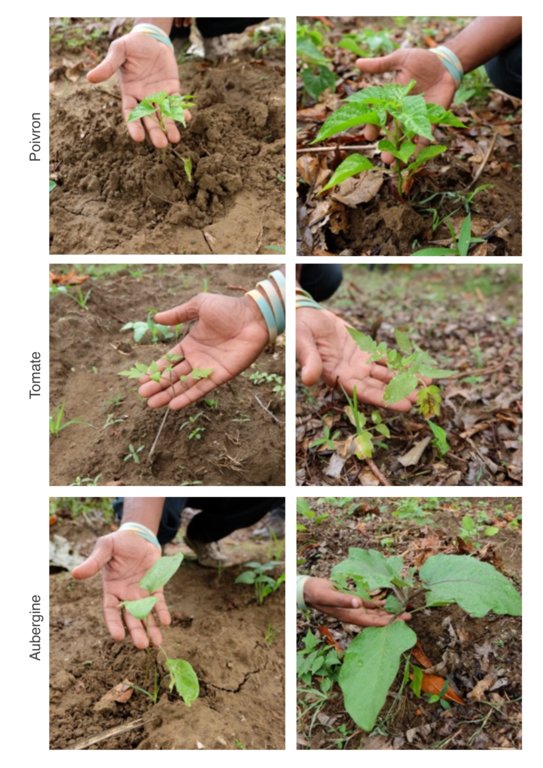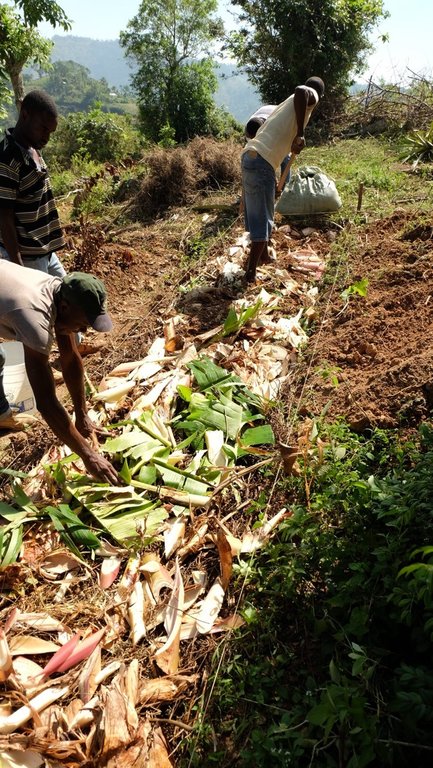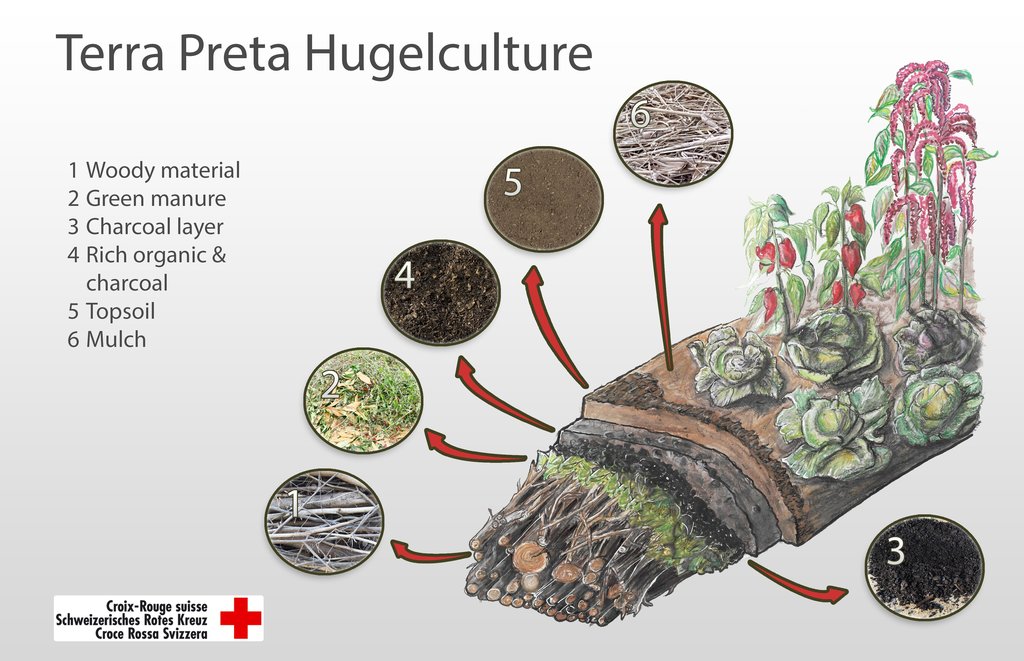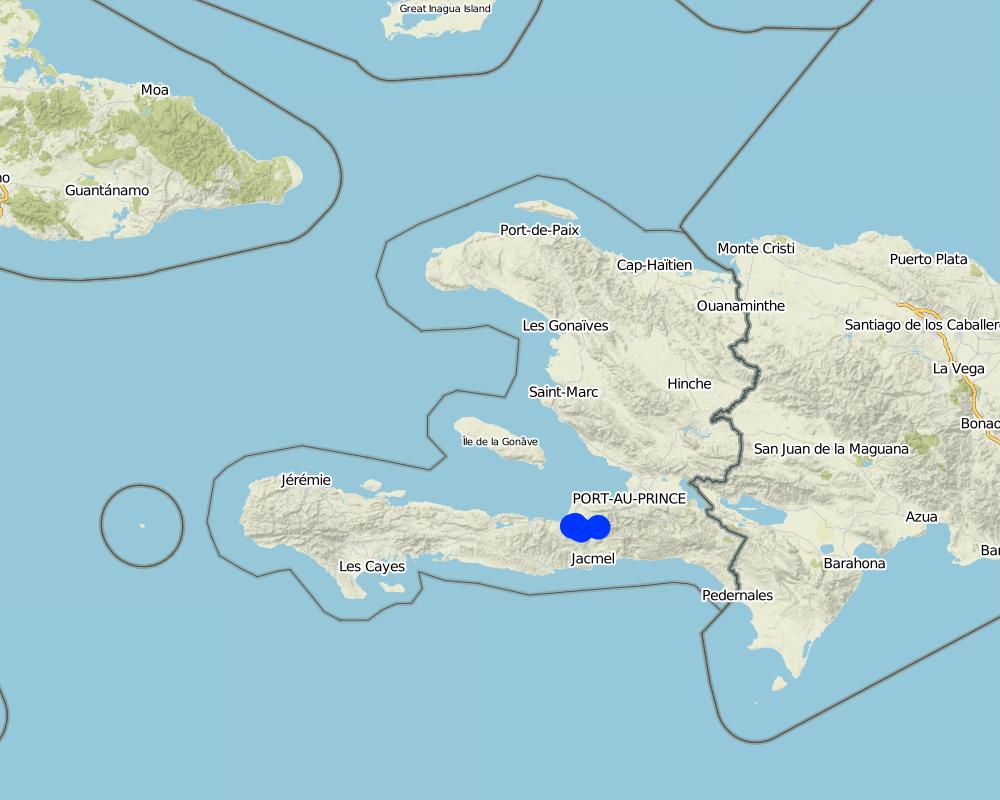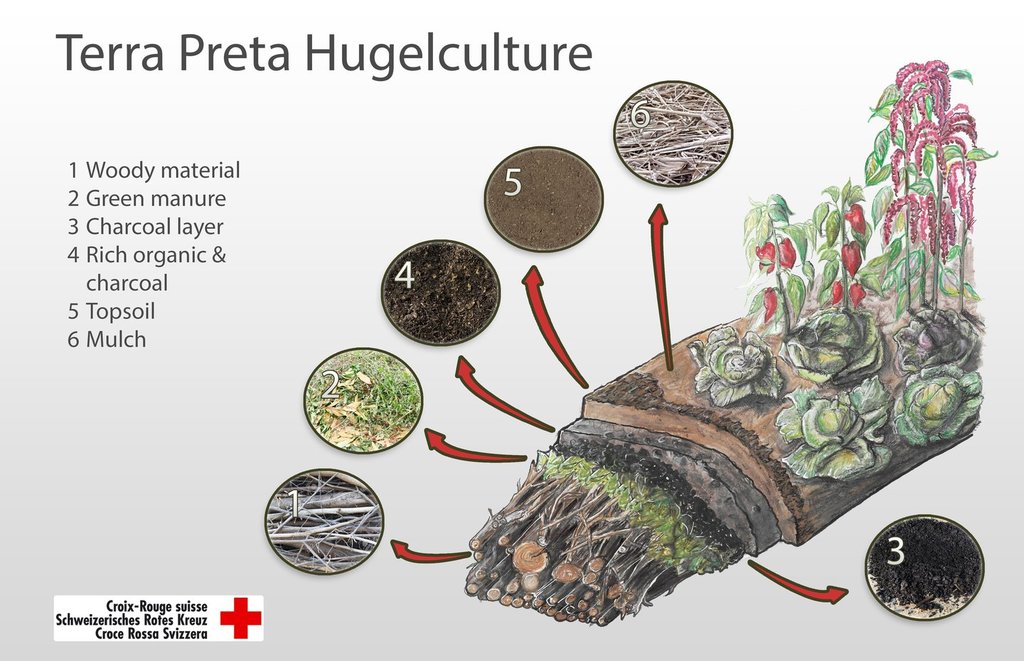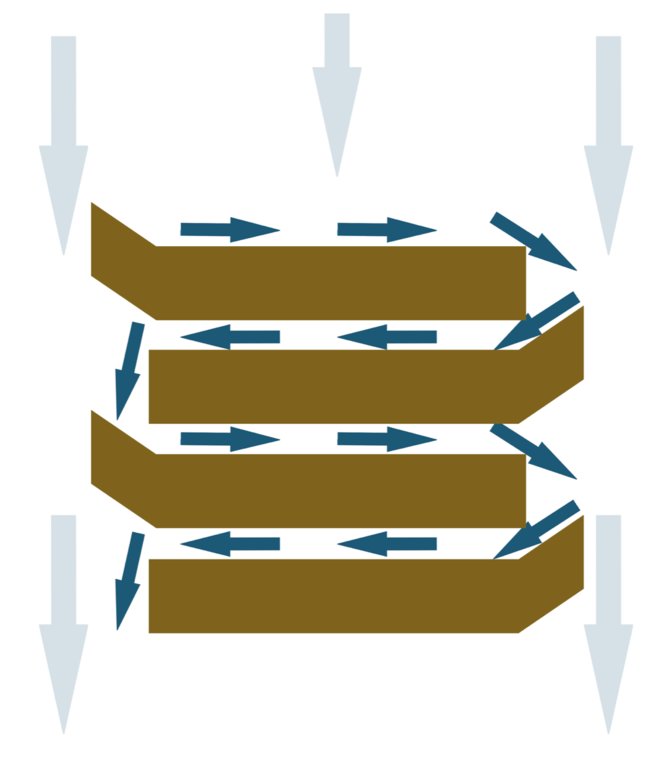Terra Preta raised garden beds [Haiti]
- Criação:
- Atualização:
- Compilador/a: Karl Harald Bier
- Editor: Anton Jöhr
- Revisores: Alexandra Gavilano, David Beritault
Jaden kolin, Tè mirak
technologies_935 - Haiti
Veja as seções
Expandir tudo Recolher tudo1. Informação geral
1.2 Detalhes do contato das pessoas capacitadas e instituições envolvidas na avaliação e documentação da tecnologia
Nome do projeto que facilitou a documentação/avaliação da Tecnologia (se relevante)
Book project: where people and their land are safer - A Compendium of Good Practices in Disaster Risk Reduction (DRR) (where people and their land are safer)Nome da(s) instituição(ões) que facilitou(ram) a documentação/ avaliação da Tecnologia (se relevante)
Swiss Red Cross (Swiss Red Cross) - Suíça1.3 Condições em relação ao uso da informação documentada através de WOCAT
Quando os dados foram compilados (no campo)?
08/12/2016
O/a compilador/a e a(s) pessoa(s) capacitada(s) aceitam as condições relativas ao uso de dados documentados através da WOCAT:
Sim
1.4 Declaração de sustentabilidade da tecnologia descrita
A tecnologia descrita aqui é problemática em relação a degradação da terra de forma que não pode ser declarada uma tecnologia de gestão sustentável de terra?
Não
1.5 Referência ao(s) questionário(s) sobre as abordagens da GST
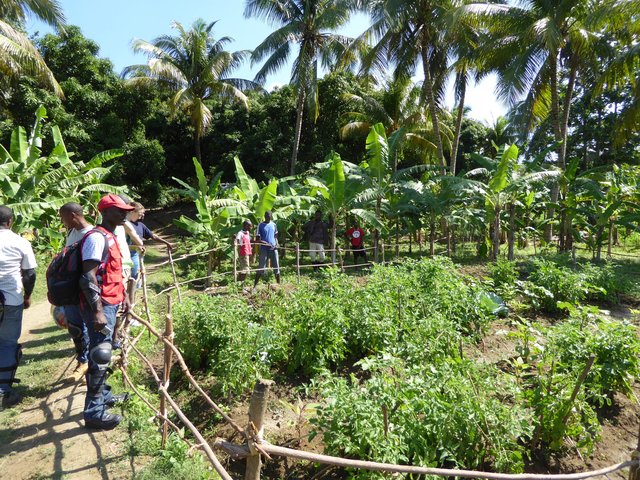
Approche au niveau ménage pour jardins Terra Preta [Haiti]
L'approche des jardins Terra Preta au niveau ménage, avec des jardins de démonstration crée avec des membres des Organisations Communautaires de Base (OCB), facilite la vulgarisation de la technologie Terra Preta parmi la population vulnérable des zones rurales de la commune de Léogâne, Haïti.
- Compilador/a: Helen Gambon
2. Descrição da tecnologia de GST
2.1 Descrição curta da tecnologia
Definição da tecnologia:
Terra Preta raised garden beds are a combination of techniques from permaculture and the production of Terra Preta, an anthrosol. These garden beds, which were created with local resources, are highly fertile and enable the production of much higher yields than traditional techniques, while diminishing soil erosion.
2.2 Descrição detalhada da tecnologia
Descrição:
One of the major problems in the mountainous rural zones of the municipality of Léogâne in Haiti is the severe degradation and erosion of soils. The soil loss aggravates the vulnerable situation of the local population, mainly farmers. The Terra Preta raised garden beds were introduced in this region after the earthquake of 2010, and were replicated by several organisations and also by members of the communities. They are based on two main techniques:
1) Terra Preta is a technique to create soils based on a lacto-acidic fermentation of organic matter with charcoal powder. This technique was used by indigenous people in Amazonia, and rediscovered and replicated recently by scientists. The technique is characterised by the use of local resources and a high fertility. With this technique, a soil layer of several decimeters can be produced in a few years, whereas this takes normally around 100 years per centimeter. Soil analyses show that the formation of humic acids can be demonstrated after 4 months.
2) Raised garden beds (Hugelculture) are a technique from permaculture. Permaculture is a science of agricultural and social systems which uses the principles of ecology and the knowledge of traditional societies to simulate the diversity, stability and the resilience of natural ecosystems. Raised garden beds consist of an interior of ligneous material, covered by a layer of earth. The elevated construction facilitates the work in the garden and the decomposition of wood inside the beds. Due to their spongy structure, the raised garden beds function as a water reservoir during dry periods.
The garden beds are placed perpendicularly to the slope direction as much as possible, and are arranged alternately, with an extension to redirect the surface runoff towards the structures. This arrangement prevents the water from draining directly. This promotes the infiltration of water into the soil, where it is captured by the ligneous material, which prevents erosion (see the photograph).
The following inputs to the garden beds can be found locally:
- Organic matter: ligneous material, dry straw, fresh straw, harvest residues, organic residues rich in NPK (kitchen waste, animal waste, etc.),
- Charcoal powder (biochar),
- Possibly ashes or other fertile materials.
With these materials, which are generally without cost and locally available, a raised garden bed can be set up in less than an hour. Even without additional fertilisation after the set up, the technique offers the possibility to have several cycles of vegetable production. Experiments showed good results during 4 years of continuous plantation in Thozin (Grand Goâve). In order to secure soil fertility for many years, organic matter can be added after the period of plantation. It can be easily incorporated below the first layer of soil, and the decomposition takes place automatically. When put in place on sloping terrain, the garden beds slow down erosion strongly, and can serve to protect houses.
The technique is valued because of its cost-effectiveness and its sustainability compared to known techniques. The complexity of the implementation can be a limiting factor for an autonomous replication by the beneficiaries. That is when they see the set-up of the structures and think they know how to replicate it without taking account of all the details which are essential for the good functioning of the structures. This is why generally a certain level of support by technicians is required.
2.3 Fotos da tecnologia
2.5 País/região/locais onde a tecnologia foi aplicada e que estão cobertos nesta avaliação
País:
Haiti
Região/Estado/Província:
West department
Especificação adicional de localização:
Municipality of Léogâne
Map
×2.6 Data da implementação
Caso o ano exato seja desconhecido, indique a data aproximada:
- menos de 10 anos atrás (recentemente)
2.7 Introdução da tecnologia
Especifique como a tecnologia foi introduzida:
- através de projetos/intervenções externas
3. Classificação da tecnologia de GST
3.1 Principal/principais finalidade(s) da tecnologia
- Melhora a produção
- Reduz, previne, recupera a degradação do solo
- Reduzir riscos de desastre
- Atenuar a mudanças climáticas e seus impactos
- Criar impacto econômico benéfico
- Cria impacto social benéfico
3.2 Tipo(s) atualizado(s) de uso da terra onde a tecnologia foi aplicada

Terra de cultivo
- Cultura anual
Principais plantações (colheitas para venda e consumo próprio):
Vegetables (for example pepper, cabbage, spinach, tomato, chili pepper)
Comentários:
With this technique, marginal land can be cultivated. The soil in place does not play a very important role because the nutrients are contained in the inputs.
Caso o uso da terra tenha mudado devido a implementação da tecnologia, indique seu uso anterior à implementação da tecnologia:
The technology enables the production of vegetables on land that was not productive before (degraded soils, sandy or inert substrates). This allows farmers to diversify their traditional crops of maize, peas, sorghum and sweet potato with vegetables.
3.3 Mais informações sobre o uso da terra
Abastecimento de água para a terra na qual a tecnologia é aplicada:
- Precipitação natural
Número de estações de cultivo por ano:
- 2
Especifique:
The intervention zone has 2 cropping periods based on 2 rainy seasons. The Terra Preta raised garden beds are usually used all year round.
3.4 Grupo de GST ao qual pertence a tecnologia
- Gestão integrada de fertilidade do solo
- Medidas de curva de nível
- Hortas familiares
3.5 Difusão da tecnologia
Especifique a difusão da tecnologia:
- Aplicado em pontos específicos/concentrado numa pequena área
3.6 Medidas de GST contendo a tecnologia

Medidas agronômicas
- A2: Matéria orgânica/fertilidade do solo
- A3: Tratamento da superfície do solo

Medidas estruturais
- S2: Barragens, bancos
3.7 Principais tipos de degradação da terra abordados pela tecnologia

Erosão do solo pela água
- Wt: Perda do solo superficial/erosão de superfície
- Wg: Erosão por ravinas/ravinamento

Degradação biológica
- Bl: perda da vida do solo
3.8 Redução, prevenção ou recuperação da degradação do solo
Especifique o objetivo da tecnologia em relação a degradação da terra:
- Reduzir a degradação do solo
- Recuperar/reabilitar solo severamente degradado
4. Especificações técnicas, implementação de atividades, entradas e custos
4.1 Desenho técnico da tecnologia
4.2 Especificações técnicas/ explicações do desenho técnico
1. Terrain analysis:
The first step in the construction is the terrain analysis: what is the size of the terrain, the relief, the environment (vegetation, buildings, water courses) and which are the resources (water, biochar, vegetation, animals, organic residues) present in place? Specific needs and social aspects, the neighbourhood and land holdings must also be considered.
2. Elaborating a land use plan:
The second step is the elaboration of a land use plan: definition of the position of the garden beds, of the protection measures (against wind, sun and heat), and of the vegetables to grow.
3. Construction of the garden beds:
After the preparatory work, the actual construction of the garden beds begins.
- A trench of approximately 10 cm depth is dug (width of 1-1.20 m, length undefined),
- The ligneous materials (decomposing wood, of larger or smaller volume) are arranged to create a mound. Holes between the materials should be filled-up with earth.
- The organic matter is added in layers in the following order: dry straw, animal waste, pulse crops and organic matter rich in NPK.
- Charcoal powder can be added between the layers of rich organic matter, or even better, mixed with the latter.
- A layer of earth of approximately 10 cm is added as cover.
- During the process of construction, every layer should be watered.
The establishment of multiple garden beds is done as described in figure 2 above. The garden beds are installed in alternation with an extension to redirect the surface runoff towards the structures. The water is forced around the structures, which will facilitate the infiltration of the water and the deposition of sediments. As a result, the water is captured in the garden bed, and erosion is reduced. A more detailed description with illustrations is given below.
4.3 Informação geral em relação ao cálculo de entradas e custos
Especifique como custos e entradas foram calculados:
- Por unidade de tecnologia
Especifique a unidade:
isolated structure
Especifique volume, comprimento, etc (se relevante):
width: 1.10 m; length: 10 m
Outro/moeda nacional (especifique):
Haiti Gourde
Indique a taxa cambial do dólar norte americano para a moeda local (se relevante): 1 USD =:
68,0
Indique a média salarial da mão-de-obra contratada por dia:
250
4.4 Atividades de implantação
| Atividade | Tipo de medida | Periodicidade | |
|---|---|---|---|
| 1. | Outlining of raised garden beds | Outras medidas | year-round |
| 2. | Collection of materials | Outras medidas | year-round |
| 3. | Digging a basin along the contour | Estrutural | year-round, preferably at the start of the rainy season |
| 4. | Building the different layers (wood, dry straw, fresh straw, pulse crops and organic matter rich in NPK, earth, charcoal powder) | Estrutural | year-round, preferably at the start of the rainy season |
| 5. | Replanting of vegetable seedlings | Agronômico | year-round, preferably at the start of the rainy season |
| 6. | Watering | Agronômico | year-round, preferably at the start of the rainy season |
4.5 Custos e entradas necessárias para a implantação
| Especifique a entrada | Unidade | Quantidade | Custos por unidade | Custos totais por entrada | % dos custos arcados pelos usuários da terra | |
|---|---|---|---|---|---|---|
| Mão-de-obra | Skilled labour (technical support) | person-days | 0,5 | 3000,0 | 1500,0 | |
| Mão-de-obra | Unskilled labour (construction) | person-days | 1,0 | 250,0 | 250,0 | 100,0 |
| Equipamento | Tools (spade, pickaxe) | piece | 1,0 | 5,0 | 5,0 | 100,0 |
| Material vegetal | Seedlings of cabbage | seedling | 10,0 | 10,0 | 100,0 | |
| Material vegetal | Seedlings of spinach | seedling | 20,0 | 5,0 | 100,0 | |
| Material vegetal | Seedlings of tomato | seedling | 10,0 | 5,0 | 50,0 | |
| Material de construção | Decomposing wood | batch | 1,0 | 200,0 | 200,0 | 100,0 |
| Material de construção | Earth | batch | 1,0 | 50,0 | 50,0 | 100,0 |
| Material de construção | Dry straw | batch | 1,0 | 100,0 | 100,0 | 100,0 |
| Material de construção | Fresh straw | batch | 1,0 | 100,0 | 100,0 | 100,0 |
| Material de construção | Animal waste | Bag | 1,0 | 100,0 | 100,0 | 100,0 |
| Material de construção | Charcoal/biochar | kg | 50,0 | 2,0 | 100,0 | 100,0 |
| Custos totais para a implantação da tecnologia | 2655,0 | |||||
Se o usuário da terra arca com menos que 100% dos custos, indique quem cobre os custos remanescentes:
Swiss Red Cross
Comentários:
The land users have the necessary tools (5 HTG are budgeted to compensate for the use of their own tools). The construction materials are also locally available, and are generally considered as waste.
4.6 Atividades recorrentes/manutenção
| Atividade | Tipo de medida | Periodicidade/frequência | |
|---|---|---|---|
| 1. | watering | Agronômico | 3 days |
| 2. | weeding | Agronômico | 2 weeks |
| 3. | mulching | Agronômico | 2 months |
| 4. | refertilisation | Agronômico | 5 years |
4.7 Custos e entradas necessárias pata a manutenção/atividades recorrentes (por ano)
| Especifique a entrada | Unidade | Quantidade | Custos por unidade | Custos totais por entrada | % dos custos arcados pelos usuários da terra | |
|---|---|---|---|---|---|---|
| Mão-de-obra | Annual maintenance | person-days | 15,0 | 250,0 | 3750,0 | 100,0 |
| Equipamento | Watering device | piece | 1,0 | 150,0 | 150,0 | 100,0 |
| Material vegetal | Seed and seedlings | various | 1,0 | 250,0 | 250,0 | 100,0 |
| Custos totais para a manutenção da tecnologia | 4150,0 | |||||
Comentários:
The indicated costs for the seed and the seedlings are the costs on the local market, but the land users reproduce these from existing plants, that they received from the project for the first implemented raised bed.
4.8 Fatores mais importantes que afetam os custos
Descreva os fatores mais determinantes que afetam os custos:
The labour (and the technical support for the first 3-4 structures of raised beds).
5. Ambiente natural e humano
5.1 Clima
Precipitação pluviométrica anual
- <250 mm
- 251-500 mm
- 501-750 mm
- 751-1.000 mm
- 1.001-1.500 mm
- 1.501-2.000 mm
- 2.001-3.000 mm
- 3.001-4.000 mm
- > 4.000 mm
Especificações/comentários sobre a pluviosidade:
There is a dry season from December to February and a rainy season from April to October, with two peaks at the start and at the end of the period, and a relative pause in July.
Zona agroclimática
- Subúmido
5.2 Topografia
Declividade média:
- Plano (0-2%)
- Suave ondulado (3-5%)
- Ondulado (6-10%)
- Moderadamente ondulado (11-15%)
- Forte ondulado (16-30%)
- Montanhoso (31-60%)
- Escarpado (>60%)
Formas de relevo:
- Planalto/planície
- Cumes
- Encosta de serra
- Encosta de morro
- Sopés
- Fundos de vale
Zona de altitude:
- 0-100 m s.n.m.
- 101-500 m s.n.m.
- 501-1.000 m s.n.m.
- 1.001-1.500 m s.n.m.
- 1.501-2.000 m s.n.m.
- 2.001-2.500 m s.n.m.
- 2.501-3.000 m s.n.m.
- 3.001-4.000 m s.n.m.
- > 4.000 m s.n.m.
Indique se a tecnologia é aplicada especificamente em:
- Não relevante
5.3 Solos
Profundidade do solo em média:
- Muito raso (0-20 cm)
- Raso (21-50 cm)
- Moderadamente profundo (51-80 cm)
- Profundo (81-120 cm)
- Muito profundo (>120 cm)
Textura do solo (solo superficial):
- Médio (limoso, siltoso)
- Fino/pesado (argila)
Textura do solo (>20 cm abaixo da superfície):
- Grosso/fino (arenoso)
Matéria orgânica do solo superficial:
- Baixo (<1%)
5.4 Disponibilidade e qualidade de água
Lençol freático:
> 50 m
Disponibilidade de água de superfície:
Médio
Qualidade da água (não tratada):
Água potável precária (tratamento necessário)
A salinidade da água é um problema?
Não
Ocorre inundação da área?
Não
5.5 Biodiversidade
Diversidade de espécies:
- Médio
Diversidade de habitat:
- Baixo
5.6 Características dos usuários da terra que utilizam a tecnologia
Sedentário ou nômade:
- Sedentário
Orientação de mercado do sistema de produção:
- Subsistência (autoabastecimento)
Rendimento não agrícola:
- Menos de 10% de toda renda
Nível relativo de riqueza:
- Muito pobre
Indivíduos ou grupos:
- Indivíduo/unidade familiar
Nível de mecanização:
- Trabalho manual
Gênero:
- Mulheres
- Homens
Idade dos usuários da terra:
- meia-idade
- idosos
5.7 Média da área de terra própria ou arrendada por usuários da terra que utilizam a tecnologia
- < 0,5 ha
- 0,5-1 ha
- 1-2 ha
- 2-5 ha
- 5-15 ha
- 15-50 ha
- 50-100 ha
- 100-500 ha
- 500-1.000 ha
- 1.000-10.000 ha
- > 10.000 ha
É considerado pequena, média ou grande escala (referente ao contexto local)?
- Pequena escala
5.8 Propriedade de terra, direitos de uso da terra e de uso da água
Propriedade da terra:
- Indivíduo, não intitulado
- Indivíduo, intitulado
Direitos do uso da terra:
- Indivíduo
Direitos do uso da água:
- Acesso livre (não organizado)
- Indivíduo
5.9 Acesso a serviços e infraestrutura
Saúde:
- Pobre
- Moderado
- Bom
Educação:
- Pobre
- Moderado
- Bom
Assistência técnica:
- Pobre
- Moderado
- Bom
Emprego (p. ex. não agrícola):
- Pobre
- Moderado
- Bom
Mercados:
- Pobre
- Moderado
- Bom
Energia:
- Pobre
- Moderado
- Bom
Vias e transporte:
- Pobre
- Moderado
- Bom
Água potável e saneamento:
- Pobre
- Moderado
- Bom
Serviços financeiros:
- Pobre
- Moderado
- Bom
6. Impactos e declarações finais
6.1 Impactos no local mostrados pela tecnologia
Impactos socioeconômicos
Produção
Produção agrícola
Quantidade posterior à GST:
an increase of yields by 2-3 times
Comentários/especificar:
The yield usually increases 2-3 times with the introduction of the technique.
Qualidade da safra
Comentários/especificar:
The crops are more healthy and more resistant to diseases. The quality of the vegetables is better, and clients on the market of Grand Goâve pay more for the products from Terra Preta.
Diversidade de produtos
Comentários/especificar:
The majority of persons in the area are not used to vegetable growing. The technique makes it possible to grow vegetables which increase the nutritional basis (rice, pearl millet, sweet potato and peas).
Área de produção
Comentários/especificar:
Normally, the soils are not used for crop production. Through the technique production area is created. In addition, the surface increases through the undulated shape of the garden beds.
Impactos ecológicos
Ciclo hídrico/escoamento
Quantidade de água
Comentários/especificar:
a) The infiltration of water in the soil is facilitated.
b) The water is retained by the organic matter in the garden beds (especially by the decomposing wood).
Escoamento superficial
Solo
Umidade do solo
Acumulação de solo
Comentários/especificar:
Water erosion is slowed down by the garden beds, and the sediments are deposited in front of these. However, the size of the garden beds is limited, and in order to combat erosion on a larger scale additional measures must be considered, like vegetated barriers or terracing.
Compactação do solo
Matéria orgânica do solo/carbono abaixo do solo
Comentários/especificar:
Soil analyses
sample 1: 0.93%- >3.50%
sample 2: 2.04% - >5.51%
Clima e redução de riscos de desastre
Impactos da seca
Comentários/especificar:
In the dry periods, the technique permits to continue crop production during several weeks without irrigation.
Emissão de carbono e gases de efeito estufa
Comentários/especificar:
Sequestered in the soil by the charcoal and the organic matter (especially the ligneous material).
6.2 Impactos externos mostrados pela tecnologia
Disponibilidade de água
6.3 Exposição e sensibilidade da tecnologia às mudanças climáticas graduais e extremos/desastres relacionados ao clima (conforme o ponto de vista dos usuários da terra)
Extremos (desastres) relacionados ao clima
Desastres meteorológicos
| Como a tecnologia lida com isso? | |
|---|---|
| Tempestade tropical | moderadamente |
| Temporal local | muito bem |
| Trovoada local | bem |
6.4 Análise do custo-benefício
Como os benefícios se comparam aos custos de implantação (do ponto de vista dos usuários da terra)?
Retornos a curto prazo:
muito positivo
Retornos a longo prazo:
muito positivo
Como os benefícios se comparam aos custos recorrentes/de manutenção(do ponto de vista dos usuários da terra)?
Retornos a curto prazo:
muito positivo
Retornos a longo prazo:
muito positivo
6.5 Adoção da tecnologia
- 1-10%
Se disponível, determine a quantidade (número de unidades familiares e/ou área abordada):
>300 households
Entre todos aqueles que adotaram a tecnologia, quantos adotaram espontaneamente, ou seja, sem receber nenhum incentivo material/pagamentos?
- 50-90%
Comentários:
Small quantities of seed were given.
6.6 Adaptação
A tecnologia foi recentemente modificada para adaptar-se as condições variáveis?
Não
6.7 Pontos fortes/vantagens/oportunidades da tecnologia
| Pontos fortes/vantagens/oportunidades na visão do usuário da terra |
|---|
|
Strongly increased yield |
| Improved product quality (size, taste) |
| Shortened crop cycle |
| Pontos fortes/vantagens/oportunidades na visão do/a compilador/a ou de outra pessoa capacitada |
|---|
| Increased production (several times) |
| Improved nutrition |
| Income generation for the farmers |
| Shortened production cycle |
6.8 Pontos fracos, desvantagens/riscos da tecnologia e formas de superá-los
| Pontos fracos/desvantagens/riscos na visão do usuário da terra | Como eles podem ser superados? |
|---|---|
| More work than traditional techniques. The latter are focused on agricultural production in fields (maize, pearl millet, sweet potato, peas/beans), and require considerably less daily maintenance. | By having the gardens close to the house for follow-up and support. |
| Pontos fracos/vantagens/riscos na visão do/a compilador/a ou de outra pessoa capacitada | Como eles podem ser superados? |
|---|---|
| Complexity of the technique | Regular education, follow-up and continuous support |
7. Referências e links
7.1 Métodos/fontes de informação
- visitas de campo, pesquisas de campo
80
- entrevistas com usuários de terras
30
- entrevistas com especialistas em GST
D. Buchon, external consultant
7.2 Referências às publicações disponíveis
Título, autor, ano, ISBN:
Terra Preta: Production. Guide des méthodes de la production de Terra Preta dans les jardins potagères. Karl Harald Bier. 2013.
Disponível de onde? Custos?
Welthungerhilfe
Título, autor, ano, ISBN:
Pas de la mise en place d'un Jardin Colline TP. Karl Harald Bier. Swiss Red Cross
Disponível de onde? Custos?
info@redcross.ch
7.3 Links para informação relevante que está disponível online
Título/ descrição:
Terra Preta - Charbon bio - Climatefarming, Hans-Peter Schmidt, 2008, ISSN 1663-0521
URL:
http://www.ithaka-journal.net/climatefarming-fr1?lang=fr
Links e módulos
Expandir tudo Recolher tudoLinks

Approche au niveau ménage pour jardins Terra Preta [Haiti]
L'approche des jardins Terra Preta au niveau ménage, avec des jardins de démonstration crée avec des membres des Organisations Communautaires de Base (OCB), facilite la vulgarisation de la technologie Terra Preta parmi la population vulnérable des zones rurales de la commune de Léogâne, Haïti.
- Compilador/a: Helen Gambon
Módulos
Não há módulos



